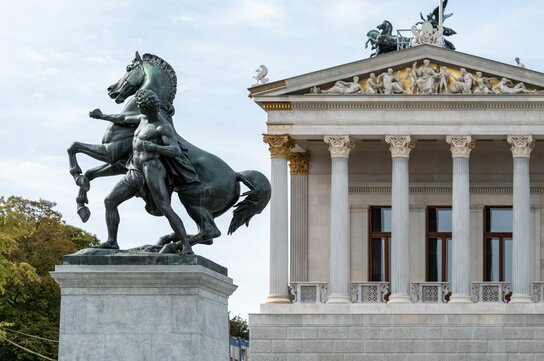Long desired (Re-) Opening
The political centre of Austria finds its way back to Dr. Karl Renner-Ring 3 this Thursday. The opening will be accompanied by a large celebration held by the National and Federal Councils as well as other political institutions. The relocation of the instances and the furnishing of the building have been in full swing since autumn 2022. On 14 and 15 January, the Parliament will open its doors to the public for the first time again: on two open days, all interested parties are invited to visit the renovated building. The newly built visitor centre, which provides information on the history and democracy of the Republic, is considered a visitor magnet. The completely glazed walkway around the session hall will allow guests to follow political events up close in future.
A Building with History and Future
The new old parliament combines tradition with modernity: in order not to lose the charm of the building, numerous elements have been renovated in a way that preserves its historical value. Among other things, the surfaces of the historic meeting hall, the pillared hall and the upper vestibule were restored. But new designs and materials were also introduced ‒ including the glass dome above the National Council Chamber, the extension of the attics, the visitor centre and the four new main staircases. The upper floor was completely refurbished, resulting in a beautiful combination of old and new.
Access permitted
Lindner was involved in the project with around 21,000 m² of the FLOOR and more® hollow floor as well as heated and chilled ceilings. For the listed restoration of the floor, the old floor construction was removed and the historic stone panels were removed, categorised and stored on site. This was followed by the assembly of the new hollow floor ‒ which now houses almost the entire building services, for example data and water lines as well as underfloor heating.
The installation of the floor system posed various challenges: On the one hand, the exact measurement of the hollow floor surfaces proved to be difficult, as the historic wall surfaces were protected during the construction phase. Furthermore, the necessary edge distances for the historic edge friezes, which lie in the mortar bed due to the different material thicknesses, had to be maintained. This required well-founded logistical measures: Among them was the exact positioning of the stored materials, which was necessary for the clean installation of the different floor types. At the same time, this made it possible to avoid additional costs for possible rearrangements. Therefore, it was possible to preserve the historic core of the building and yet incorporate the latest technology and modern interior fit-out. The successful cooperation between the contractor and the client, Bacon Gebäudetechnik GmbH, also made the project work much easier.
Find out more about the project and the construction progress under our Projects in Progress.
